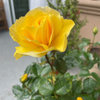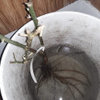Title: "Host-range studies, genetic diversity and evolutionary relationships of ACLSV isolates from ornamental, wild and cultivated Rosaceous species"
Published in: Plant Pathology (2014), volumn 63, pages 63-71.
Authors: A. T. Katsiani(a), V. I. Maliogka(a), T. Candresse(b)(c) and N. I. Katis(a)*
Authors affiliation:
(a) Plant Pathology Laboratory, School of Agriculture, Aristotle University of Thessaloniki, 54124, Thessaloniki, Greece; bINRA, UMR 1332
(b) Biologie du Fruit et Pathologie;
and
(c) Universite de Bordeaux, UMR 1332 Biologie du Fruit et Pathologie, F-33140, Villenave dâÂÂOrnon, France
Fortunately the full paper is available free.
"The ornamental species, ornamental plum (P. cerasifera) and ornamental (Japanese) quince (C. japonica) showed high ACLSV prevalence (28/38 and 24/62, respectively). In rose (R. canina) and C. monogyna the virus was less frequent (2/26 and 1/40, respectively) while ACLSV was not detected in P. coccinea (firethorn; 0/29)."
"ACLSV was also detected in wild Rosaceae species such as Rubus sp. (1/2), wild cherry (Cerasus nigra, 6/ 36), Prunus spinosa (5/14), P. pindicola (1/7), P. amygdaliformis (10/81), wild rose (R. acicularis, 1/9) and wild pear (P. pyraster, 1/43)."
"ACLSV was also detected both by ELISA and RT-PCR assays in rose (R. canina), Rubus sp. and P. pindicola and therefore these species may represent newly recorded natural hosts (Table 3)."
"ACLSV was also detected in rose (R. canina) and the wild species Rubus sp. and P. pindicola, which could represent previously unidentified natural hosts. Nevertheless, because no sequence data could be obtained from the amplicons, further research is needed to support these findings."
Concerning spread:
"Even though vegetative propagation and grafting could explain virus spread and maintenance in the cultivated and ornamental plants, they cannot account for its presence in the wild species. In these hosts ACLSV could either be transmitted by seed, pollen or by a putative vector even if it has not been reported to be spread in this way (Yoshikawa, 2001)."
See:
http://onlinelibrary.wiley.com/doi/10.1111/ppa.12058/pdf
Here is a link that might be useful: link for above










jacqueline9CA
Related Professionals
West Milford Landscape Architects & Landscape Designers · Danbury Landscape Architects & Landscape Designers · Forest City Landscape Architects & Landscape Designers · Mooresville Landscape Contractors · Peabody Landscape Contractors · Azalea Park Landscape Contractors · Bowie Landscape Contractors · Brunswick Landscape Contractors · Coram Landscape Contractors · Fort Payne Landscape Contractors · Goodlettsville Landscape Contractors · Mastic Beach Landscape Contractors · New Cassel Landscape Contractors · Rockland Landscape Contractors · Salem Landscape Contractors